![]()
See some of my "belongings": |My Book List | Archive Pictures | Link to SMKPM Online | Alumni SMKPM |
| Home | 1964 | 1965 | 1966 |
![]()
The Year 1965
 |
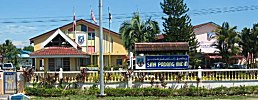 SMKPM in 2003, from this view, minus a few small added structures, including the gate and the fence, and the floras, it is about the same as the view in 1965; obviously a lot of changes must have taken place inside. |
 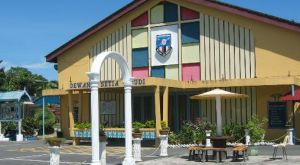 The hall, then and in 2003. It appeared that it had been named: Dewan Setia Budi. CheGu Ishak Haron stood on the flower bed coaching us to sing correct 'Negaraku'. The class blocks are on the left of the pictures, the first, closer to the hall sited the school office, with attched Head Master office, followed by the Staff Room, a WC, and a shedded path connecting the canteen. The other building run in parallel, from the perimeter extending to become the 2-labs block; one lab for life science (kaji hayat [bilogy], and the other physical science (physics and chemistry). CheGu Osman and CheGu Ghazali Haron were the science teachers. |
I was in Form 2A, so did most of my last year classmates, after a routine seiving based on the final year exam in Oct last year (for simplicity, only Bahasa Melayu, English and Ilmu Hisab [math] were examed - others were not). I was very much looking forward to go on. There were six classes of form two, from six classes of form one last years. The class form teacher was CheGu Abdullah, an RTC trainee, and he taught Math. CheGu Wan Khalid, another RTC trainee taught English. I remembered he spent much of the time teaching us "parts of speech" in his too malayness English. I remembered both CheGu Abdullah and CheGu Wan Khalid were "observed" by their respective supervisor in our class. CheGu Hussein, the hostel warden taught us Literature. In a class, we were discussing about MALAYSIA, then was just in the formation, and listening to the word MALAYSIA, Mohd Jusoh (small) [another one was Mohd Jusoh (big)] spontaneously shouted "Melayu mati"; CheGu Hussein was very furious; with his eyes circularly opened behind his thick pair of glasses, he asked Mohd Jusoh to stand on the desk throughout the period [Incidentally both Mohd Jusoh did not survived the A class; before the year end the big Mohd Jusoh quitted the school all together, and the small Mohd Jusoh dropped to B class the following year - we were replenished with two pairs of name-pair: Abdullah Embong (A and B) and Ismail Mohamad (A and B)]. CheGu Ghazali Haron taught Science, CheGu Rahmat Saripan (history), CheGu Rahim Tahir, CheGu Maimunah taught us Ilmu Alam (geog), and CheGu Ibrahim Sihi taught us Civic and PE. CheGu Yahya taught us Art; he seemed to be especially keen in "Bali Painting", the subject he firstly taught us in his art class.
 Update 2006 Apr 14 Fri, Dewan Bahasa dan Pustaka. I saw CheGu Ishak several times in a distant; but today, I managed to grab his hand and reopen the "Negaraku"; he loughed aloud like almost closing his eyes. Here I was with Prof Dr Ishak Haron, 40 years later, both attending the launching of EST by the Minister of Education; Update 2006 Apr 14 Fri, Dewan Bahasa dan Pustaka. I saw CheGu Ishak several times in a distant; but today, I managed to grab his hand and reopen the "Negaraku"; he loughed aloud like almost closing his eyes. Here I was with Prof Dr Ishak Haron, 40 years later, both attending the launching of EST by the Minister of Education; |
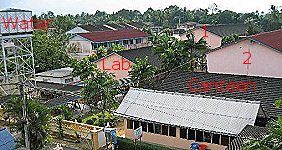 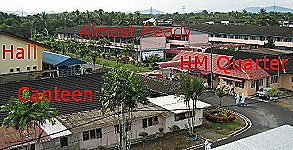 Those days in current matrix: the water tank, The Lab, The Class-room blocks 1 & 2, the Canteen, The Hall, The Head Master Quarter, the two new buildings for Industrial Arts not yet fully equiped for use. The picture were probably taken from the boys hostel high position. Structures other than the marked, were absent in those days; inside the school the flora were only shrubs, but outside were fruits orchard and coconuts. |
 The dorm was a small dorm; the dorm-mates of R3 in late 1965 posing with the background of our water tower setup, facing the foot-path from lab block (left) to the hostel (right): From left, Front row: Mohamad Sulaiman (F2), Md Ariffin Musa (F2); Middle row Abdul Rahman (F4), Mansor Abdul Rahman (F4), Alias Mohamad (F5 - Room head, a hostel prefect), Nordin Abu Bakar (F4), Mat Zakaria (F2); Back row: Razali Yusof (F2), Abdullah Embong (F2), Abdullah Che Din (F2), Anuar Rushdi (F2), Mamat Ibrahim (F5 - Assist Room head), Mohamad Awang (F2), Mohd Shahir (F2) and Ali Yatim (F2) Most of us stayed in this room for two years to 1966. Ali's bed was on my right who was on Alias's left (the wall site - room head). Mohamad Awang's bed was in the opposite rows. Unlike in SS, my bed was 'well-equipped', as the beds of others, but in many ways I was very much behind in many 'accessories', many times I borrowed Mohamad Awang's (leather) shoes to go to town, or for casual wearing.  More of the same boarders. See how nice the room head was, he let me wear his neck-tie; L to R: Mohamad Awang, Mansor, Abdullah, Alias, Ali Yatim, Mat Zakaria, and Abdul Rahman. Hey, I was wearing the trouser. That was my first trouser, tailored in KT for fifteen ringgit.  Arif the son of Utz Yusof of Padang Midin Mosque. Heard about him in 1964 in SS, heard again in 1965 and 1966 in Padang Midin, met for the first time in 1976 in Damansara Utama, and came to my home in Aug 2002. |
Updated 2005 Jun 18 Sat: In a mission to locate our beloved teacher, CheGu Saadiah and CheGu Ahmad Yahya, in Kapar, Klang. CheGu Saadiah told me that she met Azizah in Kuala Lumpur then quite recently. They recognised each other, uneroded, over that long period of time. And the reunion was in tears. |
Only six dorms were occupied in the hostel; four on the top floor, and two ground floor. The remaining ground floor was for recreational room; to 1966 end, it has only one table-tennis table. The warden was CheGu Hussien Hj Ahmad, and his bachelor quarter was on top floor at the entrance stair. The school fence was only about five feet from the hostel corridor, and outside the fence was the local's rambutan orchard with the branches extended into the hostel compound. Thus in fruit season their fruits were inside our hostel, and it was a hell of a job by the warden and the prefects to stop the temptation of the boarders to pick the fruits. The dining hall was at the back of the hostel; a (manual) copper bell reminded the boarders of meal times (striked by a hostel prefect). The meal in the hostel was better than that of the SS hostel last year, in that they were more of local recipe, and the desert, although no more apple, were a variety of local fruits: papaya, melon, banana, even pineapple; and we came to know that the contractor was Wan D, a local, and the contracts was for the cooked food, unlike in SS where the raw food stuff were contract-supplied and the school cook cooked them. Very happy with everything new in the school, the warden very frequently had his dinner with us in the dining hall (of course with additional made to custom dishes, courtesy of the contractor who delightedly entertained). One could expect such a rosy beginning would gradually rot, and yes as the days went by, it rotted like the fish the contractor supplied rotted. At one point, he had not been seen around the dining hall for many weeks. Nonetheless, there had never been any bad episode in the hostel; the bad food?, well we all came from homes where no food get the time to rot, the 'rotted' foods were made to rot for the recipe required that. The inhabitation around the area was so thin the for Friday prayer, we paraded to Padang Midin Mosque, about a mile further up the road. The people around the mosque were very happy to have us every week. Their locality was basically of local fruits orchards. So in fruit season (rambutan, manggis, langsat, duku, rambai), as always the haves shared their harvest with the have-nots by pooling at the mosque on Friday, feasting after the prayer. We were told by the warden not to hang around the mosque after prayer, so on the first fruit-feast at the mosque when we were re-marching back to the hostel immediately after the prayer, we were actually disappointing the mosque people, and especially so because we were kiddies. On the following week, they 'reacted', they posted several people at the mosque compound outlet so that we could not leave and left with no other than joining the residents feasting on the fruits, and the warden unreluctantly joined. The Imam of the mosque was Utz Yusof, he was an energetic old man, but some of his children were of about my age. At the moment the few years difference was a difference, but many tens years later the difference made no differnce, and later in different places they came to know that I had known their place before they knew me. One was Arif; I had just recalled that a talk of the table in SS in 1964 was about he got a good science results in LCE the year before and had just left for Royal Military College (RMC) in Sungai Besi, Kuala Lumpur. We surely would meet in the future somewhere. His sister, Mukminah, was then unknown to me, but would be in times to come, not because of her brother, but because of my own children, and strengthened by the person I knew when I was a school boy.
 |
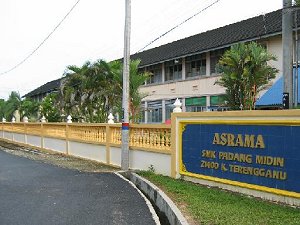 The boys hostel (asrama putra) 'back' (in 2003, no fence and gate then), at the end of the path from the lab block (canteen on the right of the path, water tower on the right); and facing the sports field. At the end of the block was the dining hall, and to the left along the field, on the right side were the teachers quarters. The front of the hostel was facing the school compound fence bordering the locals' rambutan orchard. |
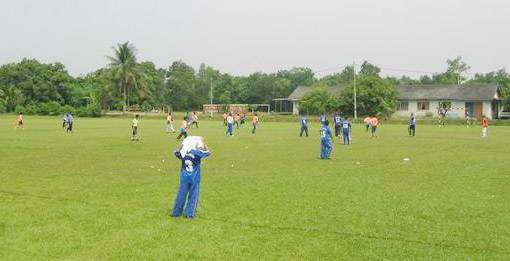 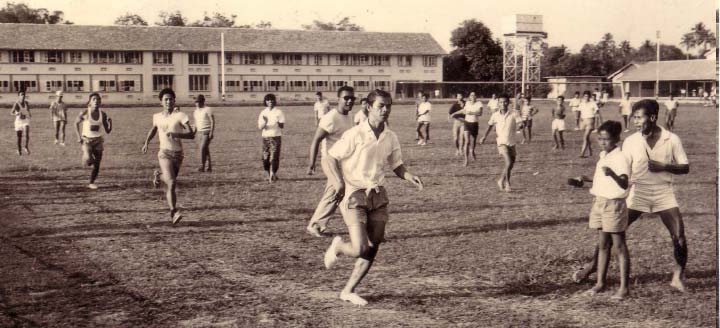 The school field in 2005 (top); teachers quarters in the background. It was mimosa-infested in 1965 (bottom); |
We were deprived of many supportive facilities. The school bookshop sold only books. There was only one shop, a cofee-shop just outside the school (perhaps opened purposedly to cater the workers who built the school). The nearest sundry shop was in Pengadang Baru, about a mile downward, but for students need of more equiped sundry shops, it was in Bukit Payong, two miles upward. Otherwise one has to take the infrequent bus trip to Kuala Terengganu. As in 1964 in SS, I never fall unwell, but I cycled twice to Bukit Payong clinic (borrowed Kamariah Ali's bicycle) to have my molar extracted. On normal day, I started my day on the field right after lunch in the hostel, as early as half-past two through to seven in the evening, the dinner bell, every day including rainy day. Bakar, a form 2 senior, organised the 'play', to the extent that he pooled some money from friends to buy our own football, it was more of a stempede football. Prep class was not held in the afternoon, but after dinner, to ten we had our prep class in the recreation room.
 The minister of Education was the guest of honour; |
SMPM was officially opened on Tuesday, September 28, by the Minister of Education, YB En Mohd Khir Johari. The first students non-physical activity was also held on the day: the very raw stage show. A new name for the school was proposed during the occasion: Sekolah Menengah Dato' Amar aka Sekolah Dato Amar. The name maintained for about a year with many stationery were already printed with the name, including the badge (logo) printed in official documents including leaving certs. It was then contended that Dato Amar was not the name of a honorable person, but was a post - Chief Minister of Terengganu. I learned that after 1966 when I had left the school, its name was reverted to its locality-based name, the policy prevailing beginning at the time.
 I had an anecdote with the hostel warden, CheGu Hussein Ahmad. It was early Friday morning in April when I woke him up to tell him that I was leaving the hostel to commute to school by bicycle; my childish and foolish decision. My intention was to own a bicycle, the transport which I thought would take me anywhere in the world, the way I saw my friends would be. The model was Abdul Rahman who came from near Kuala Bekah; he had a bicycle and stayed in the hostel. I could not have both like him; it was impossible. I told this to my mother the weekend before (to quit hostel and to commute to school from home), and she did not disagree. In fact I had given her quite a trouble already for very soon she asked Abang Wi to search for a second-hand bicycle, affordable, about 30 to 40 RM; we had seen one in Pengkalan Batu. And I had taken home some of the bedding staff. I told CheGu Hussein my intention, hiding my real intention, telling him only that it was due to my financial "status quo". He knew that I was a FMS recepient. He was not happy. He gave me a twenty minutes lecture, still in his night dress, and on the twenty-first minute I changed my mind. I owed him that short Friday morning 'sermon' which many years later I take as the God's detail implementation to protect my destiny. My fate and destiny "changed" my routine, beginning after that. I woke up to discover that reading books stimulate a lot of thinking skill, a lot more than the ball dribbling skill on the mimosa-infested field. The ever-nice smell of new books actually was a condiment while one dribbles the words, equations, graphs, diagrams, etc. in the books. One can stay late at night with the books, but not with the ball, and the most important piece of discovery that made me submitted to my destiny was that it does not cost money to be skillful with the books, as compared to the costly hardwares needed to be skillful in footballing, or in any other games. This piece of discovery is very atractive to me indeed.
I had an anecdote with the hostel warden, CheGu Hussein Ahmad. It was early Friday morning in April when I woke him up to tell him that I was leaving the hostel to commute to school by bicycle; my childish and foolish decision. My intention was to own a bicycle, the transport which I thought would take me anywhere in the world, the way I saw my friends would be. The model was Abdul Rahman who came from near Kuala Bekah; he had a bicycle and stayed in the hostel. I could not have both like him; it was impossible. I told this to my mother the weekend before (to quit hostel and to commute to school from home), and she did not disagree. In fact I had given her quite a trouble already for very soon she asked Abang Wi to search for a second-hand bicycle, affordable, about 30 to 40 RM; we had seen one in Pengkalan Batu. And I had taken home some of the bedding staff. I told CheGu Hussein my intention, hiding my real intention, telling him only that it was due to my financial "status quo". He knew that I was a FMS recepient. He was not happy. He gave me a twenty minutes lecture, still in his night dress, and on the twenty-first minute I changed my mind. I owed him that short Friday morning 'sermon' which many years later I take as the God's detail implementation to protect my destiny. My fate and destiny "changed" my routine, beginning after that. I woke up to discover that reading books stimulate a lot of thinking skill, a lot more than the ball dribbling skill on the mimosa-infested field. The ever-nice smell of new books actually was a condiment while one dribbles the words, equations, graphs, diagrams, etc. in the books. One can stay late at night with the books, but not with the ball, and the most important piece of discovery that made me submitted to my destiny was that it does not cost money to be skillful with the books, as compared to the costly hardwares needed to be skillful in footballing, or in any other games. This piece of discovery is very atractive to me indeed.
 Mohd Nor Hassan, the brother of CheGu Halim. |
My mother visited me once in the hostel; the only time she visited me, in fact the only visitor I had throughout tree years my hostel-life in 1964-1966. She came with my little sister Rubaihah. It was on a late morning Sat; she did not stayed long. She brought with her for me two pieces of fried chicken she said my father cut the day before. She told me that I probably had a not too distant paternal relative studying with me here in the school. She was a girl who had moved with her father to Bukit Besi. She was Mariam, but at that time it did not matter so much to me, I have already had my close cousins Ahmad Yusof and Nawi MakDa.
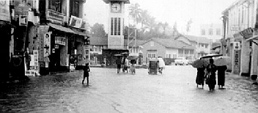 The flood, in the street of Kedai Payang; (pic courtesy of Awang Goneng) 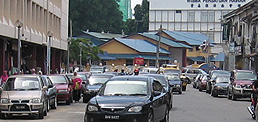 The same street in 2006 jun; the clock had been removed; the background had been added with building, but the 'surau' in the middle of the picture is in peace with an added front section; the market stalls on the left had been renovated; the shops on the right is there in the original piece. |
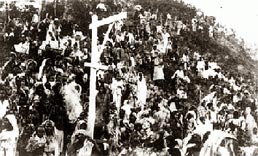 And in the "red-water" flood (ca. 1926), the people found their santuary on the hilly places; (pic courtesy of Awang Goneng) |
Edition dated May 2003.